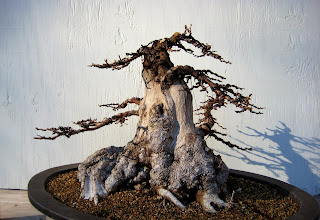At the beginning of the incredible story of Shinji Susuki, Bonsai Works of Divinity, it was said that, "a bonsai has a universe within itself." I think that analogy really fits this old, collected tree. I purchased this material from Bonsai West in the winter of 2009. I was just enamored by the enormous, melting base, however, the apex was too straight and lacked taper. In the winter of 2010, I removed the apex and most of the original branches were cut back to a stub. With assistance from local bonsai artist, Haidar Kazem, the rotting section near the apex of the tree was carved out. Over time, I realized this section could make an interesting focal point and the small tree growing out from the base could also be part of the composition if this side was made the viewing front.
The tree in 2009 at Bonsai West
A year later, before branch trimming and carving...
After pruning and during carving...
and today...


.JPG)
.JPG)































